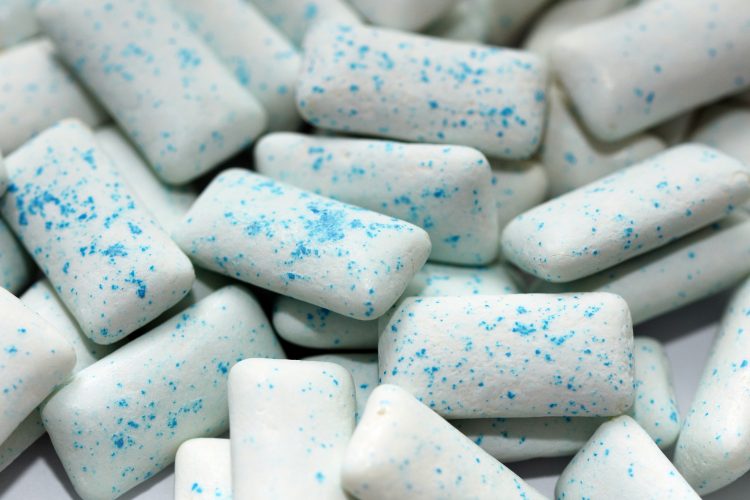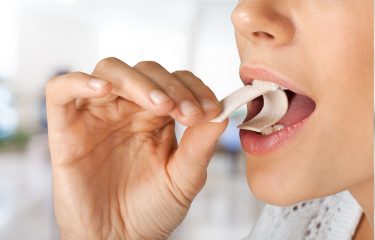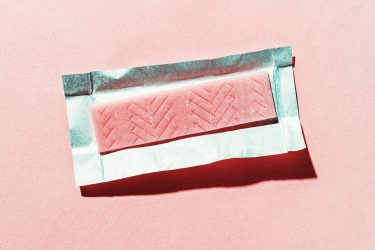Should plastic gum base be replaced with a plant-based alternative?
- Like
- Digg
- Del
- Tumblr
- VKontakte
- Buffer
- Love This
- Odnoklassniki
- Meneame
- Blogger
- Amazon
- Yahoo Mail
- Gmail
- AOL
- Newsvine
- HackerNews
- Evernote
- MySpace
- Mail.ru
- Viadeo
- Line
- Comments
- Yummly
- SMS
- Viber
- Telegram
- Subscribe
- Skype
- Facebook Messenger
- Kakao
- LiveJournal
- Yammer
- Edgar
- Fintel
- Mix
- Instapaper
- Copy Link
Posted: 1 July 2022 | Bethan Grylls (New Food) | No comments yet
With plastic microparticles in human bodies making headlines, it may be alarming to hear that gum chewers have been masticating plastic all this time. So, are there any safety implications and why isn’t plastic on the label? New Food speaks to three experts.


You may be surprised to hear that you could be chewing on polymers – the same kind of material used to make certain types of plastic.1,2 How, you might wonder? Through your chewing gum.
If you flip a packet of chewing gum over, however, you’re unlikely to find ‘plastic’ among the listed ingredients. Instead, its comprised synthetic ingredients are labelled as ‘gum base’.
According to the International Chewing Gum Association (ICGA), gum base is what gives gum that chewiness. It’s made from a mixture of food-grade polymers, waxes and softeners that create the well-known texture.
However, the Founder behind clean label chewing-gum brand Milliways believes the term ‘gum base’ isn’t transparent enough. As such, the 29-year-old is calling for clearer labelling on products still using plastic polymer- and resin-based ingredients.
New Food sat down with Milliways boss Tom Raviv to discuss his drivers for launching the brand and why he’s keen to get ‘plastic’ on labels.
“Seventy five percent of people are unaware there is plastic in chewing gum,” Raviv said. “Often that gum is made from plastic (usually the same kind as carrier bags) resin and petroleum-derived paraffin wax.”
With all the recent news around microplastics, including plastic particles being discovered in human blood, Raviv stated that he was concerned.
“There hasn’t been extensive research in terms of the actual health implications of chewing gum, but if you break down the main constituents of conventional gum, there are some red flags.
“First and foremost is the potential for microplastics to enter the body while you’re chewing. And then there are the other ingredients, some of which have been linked to possible carcinogens, such as aspartame.”
You probably don’t have to worry too much, however, as there hasn’t been any evidence published (as far as this journalist can tell) to suggest that plastic gum base is harmful. And although some studies suggest a link between cancer and aspartame, highly reputable sources have denied any such association.3,4
Should we be concerned about plastic in gum?
To quell fears around this concern, I reached out to the US Food & Drug Administration (FDA) to discuss the use of plastic gum base further.
You may wonder – with Milliways being a UK brand – why I spoke to the US officials and not the UK. I did reach out to both, but currently in the UK the rules on chewing gum compositional labelling are in retained EU law (Annex VII part B section 9 of the Food Information to Consumers regulations), which allows “All types of gum preparations used in the manufacture of gum base for chewing gum” to be designated as ‘Gum base”.
The Food Standards Agency are therefore not able to share any safety assessments on materials used as gum base, as these assessments would have been carried out while we were part of the EU. It’ll be interesting to see whether that changes anytime soon!
So, let’s focus on the US to find out a little more about their policies.
Safety assessments around gum
“In general, the FDA re-evaluates the safety of an approved food additive when new data becomes available,” an FDA spokesperson explained to New Food. “If new evidence suggests that an ingredient already in use may be unsafe, or if consumption levels have changed enough to require another look, federal authorities may prohibit its use or conduct further studies to determine if the use can still be considered safe.”


So yes, we are absorbing plastic into our bodies via numerous routes – but not necessarily through plastic chewing gum.
The FDA reviews the safety of new food additives, and if it finds its use to be safe, it issues a regulation describing the conditions of safe use.
“The FDA has evaluated the safety of many substances used to make up chewing gum base,” the FDA spokesperson continued. “The 46 substances that we have reviewed and determined to be safe for this use can be found in our regulations (title 21 of the Code of Federal Regulations, part 172, section 172.615; 21 CFR 172.615, eCFR :: 21 CFR 172.615 — Chewing gum base). The types of substances that we have evaluated as part of this regulation included masticatory substances (derived from plants as well as synthetic sources), synthetic and natural terpene resins, antioxidants and softeners (referred to as plasticising materials) such as glycerol ester of wood rosin.
“We have reviewed the safety of chewing gum base constituents many times since at least 1960 when we received a food additive petition for ingredients in chewing gum base. Even before that, we evaluated the safety of other chewing gum base ingredients on a case-by-case basis. Our most recent formal evaluation closed in April 2020. We evaluated the safety of each substance, often multiple times as new data became available. The kinds of studies we reviewed were typical for any food ingredient, for example: studies of test animals fed large amounts of a substance over a long period of time; studies to determine whether an ingredient could cause cancer; and studies to develop very sensitive methods to monitor for contaminants.
“We also reviewed studies that are more unique to substances like chewing gum bases. For example, some studies used simulated saliva and/or chewing to measure components of the chewing gum base that could dissolve out of the gum and into the saliva. We also evaluated the safety of any substances that were found to migrate out of the gum. As with any food ingredient, we revisit the safety of the use of an ingredient as appropriate when new safety information becomes available.”
More information about how food additives are evaluated can be found here: Overview of Food Ingredients, Additives & Colors | FDA
Seeking further clarity on this matter, I also approached the ICGA, who said that the ingredients used in chewing gum, including chewing gum base, vary by manufacturer. Chewing gum base gives the product a “texture desired by consumers and enables it to effectively deliver sweetness, flavour and other benefits, including demonstrated dental health benefits”.
The association spokesperson continued: “ICGA members use only food ingredients and label their chewing gum products in accordance with the laws and regulations of the countries in which they are sold. It is important to note that these ingredients have been reviewed and approved by competent food safety authorities around the world. Any suggestion that legally compliant chewing gum products contain harmful chemicals is false.”
Why is plastic allowed to be labelled as ‘gum base’?
So while that may alleviate worries around chewing plastic-based gum, the question as to why it’s labelled as ‘gum base’ – an ambiguous term at best – remains.
Commenting on this, the FDA said: “The ingredients in chewing gum must be declared by common or usual name on the label in accordance with Title 21, Code of Federal Regulations, part 101.4(a). There is not a specific regulation for ‘gum base’, but if you are referring to a ‘chewing gum base’, then we note that under 21 CFR 172.615, ‘chewing gum base’ is a food additive that may be safely used in the manufacture of chewing gum in accordance with prescribed conditions.
“For instance, the food additive consists of one or more of the provided substances, including masticatory substances and softeners (such as certain polymers and plasticising materials). Polyethylene is provided as one of the permitted substances; ‘plastic’ is not. Generally, we would not object to ‘chewing gum base’ or ‘gum base’ as the name of this ingredient.”

Thus, essentially, you can’t label it as plastic, despite polyethylene being a plastic. An interesting oxymoron.
It appears that we won’t be seeing any regulatory change anytime soon. Although with ‘plastic in gum’ making the headlines recently, it might not be long until consumers start demanding transparency – and we all know how persuasive they can be.
While Raviv and Milliways may not yet be winning the battle on calls for label transparency for the sake of honesty; alongside their concerns over health, they may achieve more success changing the opinion of regulators via their final argument…
Biodegradable plastic
According to Raviv, “chewing gum’s the second most littered item on the planet after cigarette butts”.
“North of 374 billion pieces of gum are chewed globally every single year,” he told New Food. That’s about 100,000 tonnes of plastic pollution annually.6
Milliways also states that 80-90 percent of gum is not disposed of properly, with gum being the second most littered junk on Earth. A further sobering statistic resulting from its research, is that it’s estimated to cost more than £100 million of taxpayer funding each year to remove gum from streets. Professional jet washing is employed, which sadly only serves to make the roads look cleaner rather than actually removing the plastic from the environment.
An interesting fact for you: Singapore (one of the cleanest places in the world) recognised this and made chewing gum illegal in 1992 – although you can still get some if prescribed by a doctor or dentist.
“It’s single-use plastic that never biodegrades and stays on earth forever,” said Raviv. “So either it’s stuck in our pavements until it gets pressure washed and broken into smaller pieces of gum, or if it’s discarded, let’s say responsibly and put in a bin, it just end up in landfill and never biodegrades.”
You might be wondering, as a chewing gum provider, why Milliways is so adamant to expose plastic gum base. As mentioned earlier, the company has developed a ‘clean label’ product which it says biodegrades.

“Hopefully no one’s throwing it on the streets, but if it does end up on the street, it could break down really easily, just by people walking over it or cars driving over it. And if it is thrown into a bin or it’s composted, then it’ll break down just like any other fruit or vegetable.”
Going back to its original roots (quite literally), when gum was first made from the latex sap (chicle) of the sapodilla tree, Milliways has created a natural gum base chewing gum made from the same plant.
In total, it contains only eight ingredients, including carnauba wax to give it a sparkly, crisp coating; gum arabic to bind ingredients; and magnesium stearate to help ensure consistency, among five other plant-based items.
Raviv said the process of creating the gum was challenging and the company was in the R&D stage for around a year in an effort to produce a final product that would meet consumer expectations.
He also noted that alongside the company’s views on non-plastic gum, it upheld the same values for its entire product, with its packaging being plastic free too.
Do we need a plastic chewing gum levy?
In response to the issue of plastic in chewing gum, Milliways has responded to a recent consultation by the UK Government on ‘commonly littered’ items such as single-use cups and sachets. The hope is this will limit the use of plastic in gum but also offer price parity for consumers who are often left paying a premium for plant-based alternatives.
As such, it has recommended that the plastic content of a product is printed on the packaging of gum; a levy on chewing gum products containing polymers that are derived from petroleum be implemented; and that 100 percent biodegradable, plant-based alternative gum is subject to zero-rated VAT.
References
- https://engineering.purdue.edu/MSE/aboutus/gotmaterials/Other/slone.html
- https://friendsoftheearth.uk/plastics/everyday-items-hiding-plastic
- https://ehjournal.biomedcentral.com/articles/10.1186/s12940-021-00725-y
- cancerresearchuk.org/about-cancer/causes-of-cancer/cancer-myths/do-artificial-sweeteners-cause-cancer#:~:text=No%2C%20artificial%20sweeteners%20such%20as,has%20also%20reviewed%20the%20evidence
- Leslie et al., 2022. Discovery and quantification of plastic particle pollution in human blood. Environment Intl. 163, 107199
- https://justoneocean.org/chewing-gum
Biography
Tom Raviv started the plant-based, plastic-free and planet-friendly company Milliways in 2020 with the aim of disrupting the chewing gum market and its reliance on plastic ingredients used in the gum recipe. Prior to founding Milliways, Tom worked as a consultant at Deloitte after graduating from the University of Cape Town with a degree in finance and accounting. Based in London, Tom is on a mission to drive innovation and sustainability in everyday foods and snacks.
Related topics
Ingredients, Regulation & Legislation, Sustainability, The consumer, Traceability
Related organisations
Food and Drug Administration (FDA), Food Standards Agency (FSA), International Chewing Gum Association, Milliways








